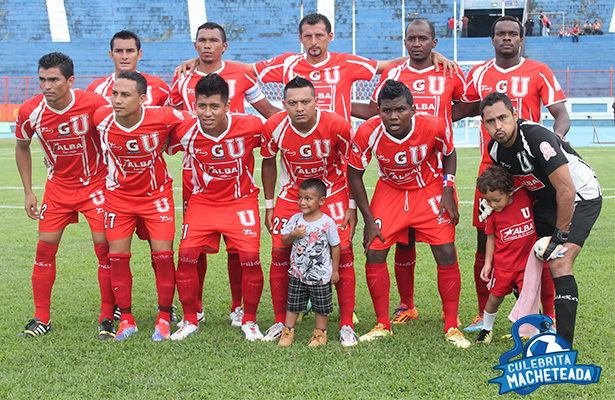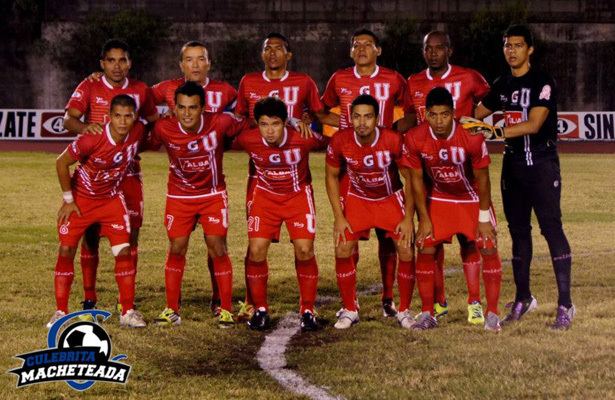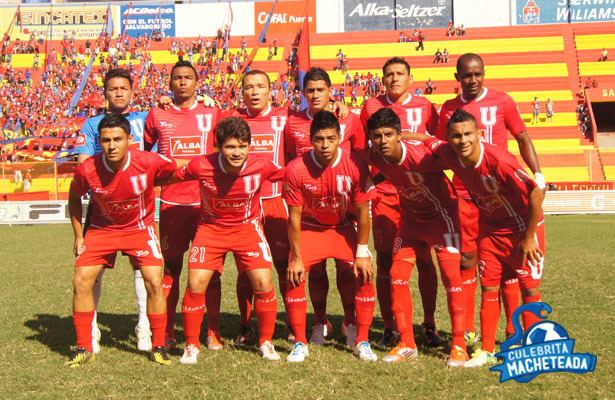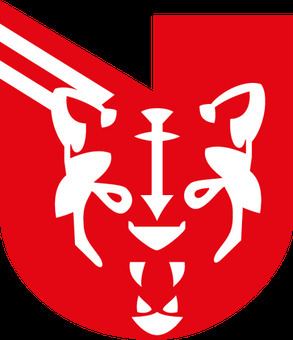Ground Capacity 10,000 Apertura 2016 Primera División 9th Founded 2003 | Chairman Rufino Quezada Website Club home page Coach Efrain Burgos | |
 | ||
Nickname(s) UESLos PumasLos UniversitariosLa Ola Roja League Salvadoran Primera División | ||
C d universidad de el salvador 2 3 sonsonate f c f tbol salvadore o liga mayor apertura j 18
Club Deportivo Universidad de El Salvador, commonly known as UES, is a professional football team in El Salvador. Universidad represents the University of El Salvador (UES), the largest and oldest university in El Salvador.
Contents
- C d universidad de el salvador 2 3 sonsonate f c f tbol salvadore o liga mayor apertura j 18
- Santa tecla f c 2 1 c d universidad de el salvador f tbol salvadore o liga mayor apertura j13
- Early History 1950 1960s
- Mid 20th century 1970s
- Decline in the late 20th century
- Champion of the Segunda Divisin and Return to the Primera Divisin
- Honours
- Grounds
- Supporters
- Current squad
- Squad Changes for Apertura 2016
- Reserve League squad
- References
On 6 June 2010, UES obtained promotion to the Primera División de Fútbol Profesional for the first time in 23 years, after beating Once Municipal 2–1.

Santa tecla f c 2 1 c d universidad de el salvador f tbol salvadore o liga mayor apertura j13
Early History (1950-1960s)

Universidad was founded in 1956. They slowly progressed up from the third division up until the Liga de Ascenso (Segunda División) where they remained there for six years.

Universidad was promoted to El Salvador's first division football league (Liga Mayor A) in the 1963–64 season. One of the key signings was that of 18-year-old Mauricio "Pipo" Rodríguez, a slender footballer with a knack for scoring spectacular goals, having considerable power with either leg. He would become the club's most influential player, even to this day.

The club's first season back was not successful at all. In that 1963–64 season, Universidad barely staved off relegation by a single point over Dragón which had managed a mere 14 points. The following season, the club had a more respectable run where it climbed to the middle of the table; however goals were hard to come by, having scored only 18 in as many games.
The 1965–66 season remains by many the most successful in the team's history. During this time, the format of El Salvador's first division changed, 4 rounds were played (36 games) instead of the customary 2 (18 games). It was during this campaign that CD Universidad was transformed. Led by "Pipo" Rodríguez, the squad became an all out attacking unit, displaying the flair that captured many of the neutral fan's attention.
However, their attacking flair (69 goals) was more than matched by Alianza, which finished top of the table with 50 points, 3 ahead of Universidad. "Pipo" Rodríguez finished as top scorer with 23 goals (tied with Alianza's Cascarita Tapia). One of the key moments occurred in the tail end of the season when CD Universidad traveled to California, United States to play a couple of exhibition matches with only 3 games left in the campaign. Later that same week, Universidad arrived back in El Salvador to play against an Once Municipal team fighting relegation. Tired Universidad players could not cope and lost the game.
For the rest of the decade Universidad, in spite of their attractive style, languished in the middle of the table finishing 6th, 7th and 8th respectively.
Mid-20th century (1970s)
The 1970 season saw another mid table finish for Universidad. However, despite their 6th-place finish, their 63 goals scored were second most in the first division and the team finished only 6 points behind eventual winner Atlético Marte, in what was one of the tightest races in the history of El Salvador's Liga A.
Universidad climbed again to the top of the table in the 1971 season. The team, reinforced with the names of Gualberto Fernández in goal and Argentine striker Joaquin Cazalbón, finished third in the league, 5 points behind eventual winners Juventud Olímpica and a single point behind Alianza. Universidad led the table for the majority of the first two rounds; however, their inability to record victories against minnows such as Excelsior and UCA cost them dearly.
The format changed, yet again in 1972, which would be the last campaign for the gifted "Pipo" Rodríguez. Injuries had taken their final toll on his knees and ankles which led to his premature retirement at the age of 27 years. The new format called for 2 rounds (18 games) and thereafter, the top six teams would battle for the championship on a home-away round-robin format (10 games). Universidad managed to qualify, finishing in a very modest 5th place and scoring only 18 goals; however, in the "Liguilla" Universidad's attacking prowess came to the front (scoring 15 goals – tops in the "Liguilla") and, ranked as outsiders to win the championship, were the last team to have a chance of overtaking Águila for the championship. Universidad lost their last game 1–2 against FAS, while Águila defeated Municipal Limeño 1–0 to become champions.
The 1973 season was a restart of sorts as the main-stay of "Pipo" Rodríguez would no longer appear in the team's lineup. His absence was also manifested in the field of play as Universidad finished in fifth place after 2 rounds and just managed to qualify for the "Liguilla". However, unlike the previous season, Universidad only managed a paltry 3 points from 10 games and did not record a single win. Their dispirited play was quite evident in their 2 games against Atlético Marte, where they were soundly beaten 3–0 and 1–0.
The 1974–75 season held a lot of promise as "Pipo" Rodríguez returned to manage the team. Two Argentines of high quality bolstered the team, central attacker Tony Rojas, who scored with headers as much as with his feet and Victor Donato, a long blonde haired technician, who became the creative conduit of the team in midfield. Tomás "Flaco" Pineda returned to CD Universidad after a successful spell with Juventud Olímpica and replaced René Puquirre in goal. With other national footballers such as Victor "El Pato" Valencia, Eduardo "La Guapa" González, Celso Jurado, Mauricio "Chino" Quintanilla and Wilfredo Peñate, Universidad had an outstanding team that could vie for the championship. In addition, "Pipo" Rodríguez also brought an 18-year-old footballer who would become one of El Salvador's most talented players of all time, Norberto "Pajarito" Huezo.
It all started well, when prior to the season, Universidad won the "Torneo Relámpago", a mini tournament which consisted of the 10 teams in first division playing 10-minute games against each other on a knockout format. In the absence of goals, corners or shots on goal determined the winner.
In spite of an inaugural 1–1 tie against perennial powers Águila, Universidad quickly climbed to the top of the table by winning their next 6 games. Important wins against newly promoted Platense (1–0) – a side that would become champions, Atlético Marte (4–1), Negocios Internacionales (3–1), Alianza (1–0) and FAS (1–0) in the first round laid out their intentions. However, after remaining unbeaten in their first 11 games (8 wins and 3 ties), injuries to key players such as "Flaco" Pineda and Tony Rojas, which kept them on the sidelines throughout most of the second half of the season, slowed Universidad's progress and their faltering form saw them miss out of the play-offs to Platense and Atlético Marte. The format had again changed to 4 rounds (36 games) with the top 4 teams staging a semi-final play-off before advancing to the final.
There were few significant changes for the 1975–76 season. Tomas "El Flaco" Pineda departed to Luis Ángel Firpo leaving Juan Méndez (acquired from Municipal Limeño) in charge of goal. Norberto "Pajarito" Huezo and Victor "El Pato" Valencia now played for ANTEL and Alianza, respectively. Mauricio "Chino" Quintanilla had matured into the team's main attacking threat alongside the talented Tony Rojas. During this season, Universidad stayed atop the table throughout the entire season. The format had changed again where the season consisted of 3 rounds where teams where divided into two groups of six teams (33 games – 12 teams) with the top 2 teams from each group qualifying for the semi-finals. Universidad recorded several impressive results, defeating FAS and Atlético Marte 1–0, Sonsonate 4–0 and the highlight of their season, a comprehensive 2–0 victory over Águila over a rainy "Flor Blanca" field in the second round, with Victor Donato majestically exerting his influence in midfield.
At the end of the season, "La U" finished in 2nd place of their group with 40 points (1-point behind Alianza; 2 points ahead of Sonsonate) and qualified for the play-offs against a top seeded and record setting Águila team which had scored an impressive 79 goals during the season, 24 more goals than its nearest competitor. Universidad went into the first leg of the semi-final game as rank outsiders, in spite of having beaten Águila 2–0 in the second round, they had lost 0–4 and 0–2 in the first and third round respectively. Universidad confounded critics and fans alike by producing a masterclass performance and besting Águila by a score of 3–1; this in spite of missing a penalty when the score was still tied 0–0. The victory afforded "La U" the luxury losing the 2nd leg (by no more than 1 goal) and still qualify for the final. However, in the return match, Universidad was a mere shadow of the team that had previously dismantled Águila and allowed their opponents complete control of midfield. The 0–3 half-time deficit was reflective of their display and even after scoring in the 2nd half to make the game 1–4, Águila cemented their place in the final with another goal to end the game at 1–5 with a 6–4 aggregate score. Universidad played against FAS for 3rd/4th place devoid of foreign footballers and managed a respectable 1–1 half-time score before losing 1–4.
For the remainder of the decade, Universidad cut back on reinforcements (Tony Rojas, Victor Donato, Juan Méndez, Roy Saénz all left the team) due to limited financial resources and was constantly battling relegation, finishing in 11th, 9th, 10th place, when finally, during the 1979–80 season, was relegated to the second division (Liga B).
Decline in the late 20th century
From the next four seasons Universidad remained on the lower half of the table often escaping relegation on the last few games of the season, eventually, however, UES fell to relegation on 21 December 1986 after a dismal season [1]. The club fortunes continued to decline struggling on the field (leading them to be relegated down to the third division) and financially, which almost lead the club to merger with Metapán FC in 1992. UES spent almost 11 years in the Tercera División before purchasing Real Santa Ana spot in the Segunda División (2002–03 season), however after a dismissal season the club was once relegated back to the Tercera División. It took another five years before UES were able to gain promotion on May 2008.
Champion of the Segunda División and Return to the Primera División
UES qualified for the final series of the 2010 Clausura of the second division. After eliminating El Roble, they defeated the highly fancied Once Municipal over two legs 3–1 in the semi-finals, before they went on to defeat Fuerte Aguilares 3–1 in the grand final and being crowned champion of the 2010 Clausura on 2 June 2010 at the Estadio Cuscatlán.[2] Thanks to winning the 2010 Clausura, it gave them an opportunity to face 2009 Apertura champion Once Municipal for the only spot to be promoted to the first division. On 6 June 2010, at the Estadio Jorge "Mágico" González UES defeated Once Municipal 2–1 thanks to goals from Williams González on the 72 min and the extra time winner by Henry Pérez on the 109 min.
Honours
Grounds
Estadio Universitario UES has been home to the UES since 2003. It has a capacity of 10,000. However due to renovations being done to Estadio Universitario UES and not being able to be finished before the start of the 2014 Apertura and also 2015 Apertura season, UES will be playing their home games at Estadio Jorge "Mágico" González.[3]
Supporters
UES has two major supporters groups; "La Ola Roja" and "La Furia Escarlata". The first of these was The Red Wave (La Ola Roja), which was formed in 2010, which was inspired from the 1970s UES crowd which supported the team during the 1970s when UES were in the Salvadoran First Division. Crowd made up with deep social and, in politics, revolutionary inclination, which is visible in the games. The crowd has a particular tradition, which is to put flags on the rails of the stage. Excepting the flag of El Salvador, other flags of several ideological friendly countries: Cuba, Venezuela, Palestine and the Basque Country. The Red Wave used to have a blanket of Homer Simpson with the U's shirt with a red star, hammer and sickle at CD UES matches. Another custom of the crowd is that its members don't allow the consumption of alcohol and drugs during the team games. At home matches, The Red Wave is located in the "General Section", in order to get involved with the people.
The Scarlet Fury (La Furia Escarlata), accompanying the team since it was in the Ascent League of El Salvador, is the latest organized crowd. It is a crowd that has its location in the Faculty of Engineering and Architecture at the University of El Salvador. The members of this crowd identify themselves with the idea of accompanying the CD UES team to away matches, encouraging the team in all matches. As a particular custom, at games, the crowd has some blankets with the pet of Iron Maiden band, Eddie the Head, adapted to the team colors and identity: Eddie U. La Furia Escarlata is the crowd with the largest number of blankets in quantity and size, recently organized in subsidiaries, each in each faculty of UES.
Current squad
As of Apertura 2016:
Note: Flags indicate national team as defined under FIFA eligibility rules. Players may hold more than one non-FIFA nationality.
Squad Changes for Apertura 2016
In:
Out:
Reserve League squad
UES reserve squad plays in the twelve-team Primera División Reserves (El Salvador). Current members of the squad are:
Note: Flags indicate national team as defined under FIFA eligibility rules. Players may hold more than one non-FIFA nationality.
